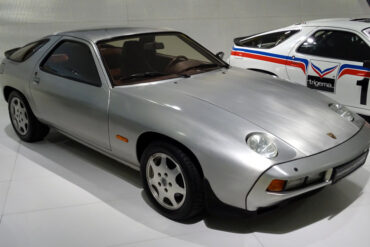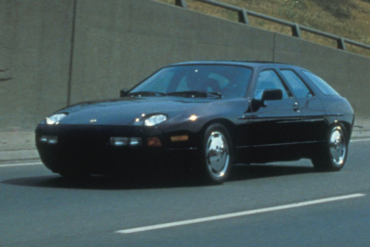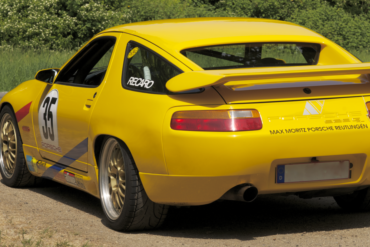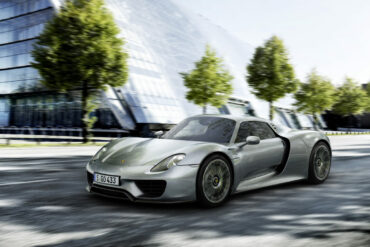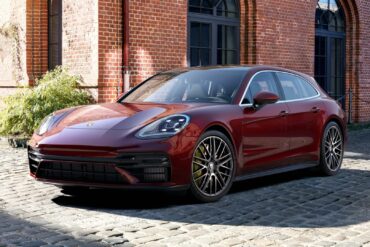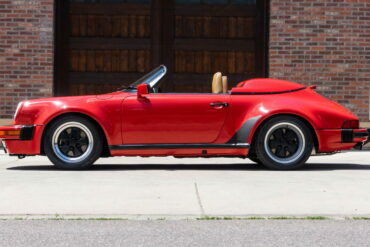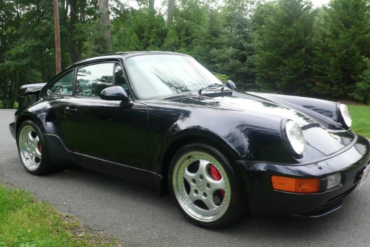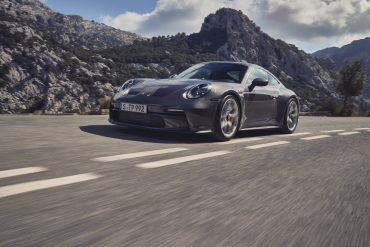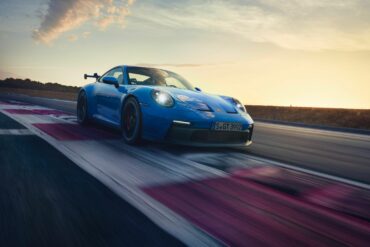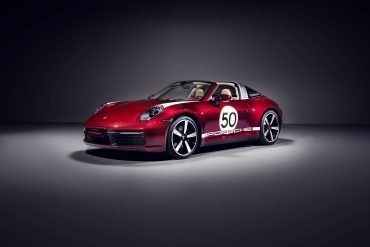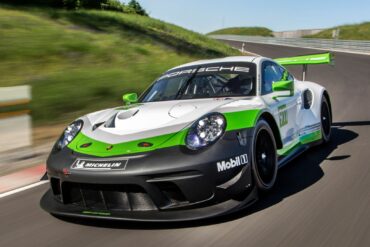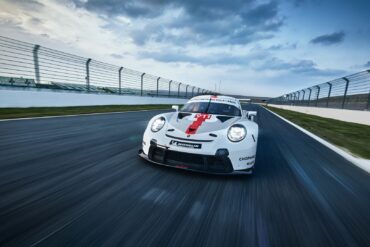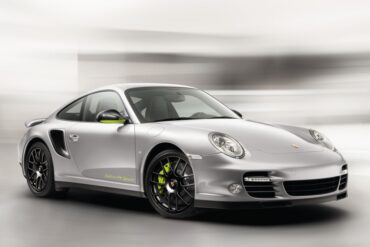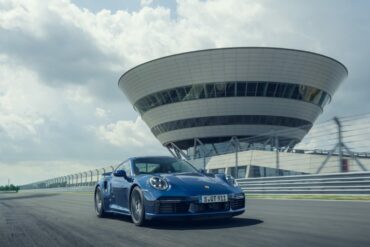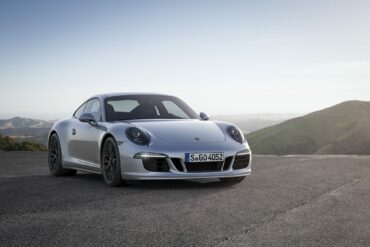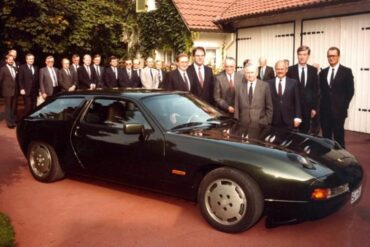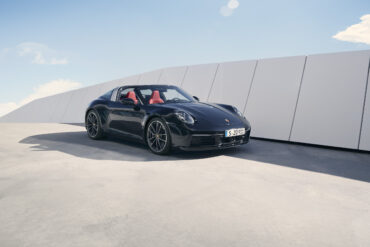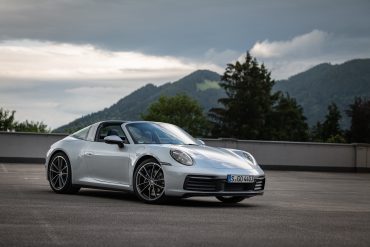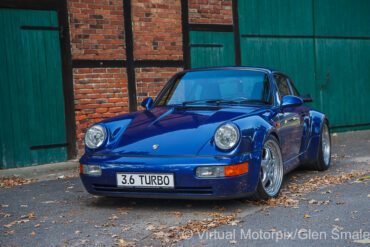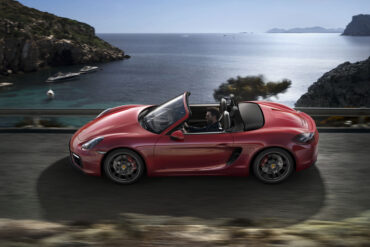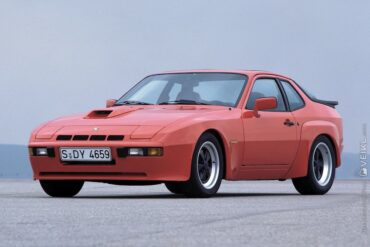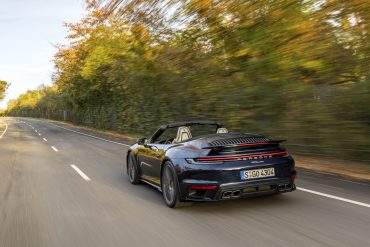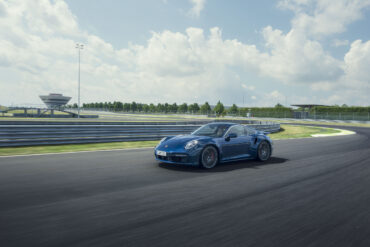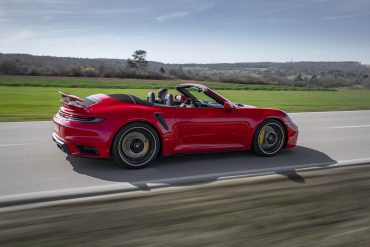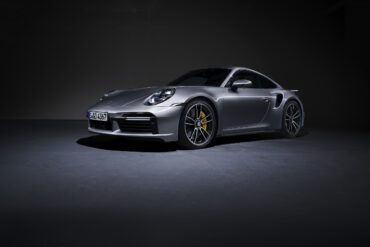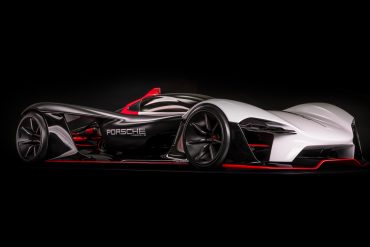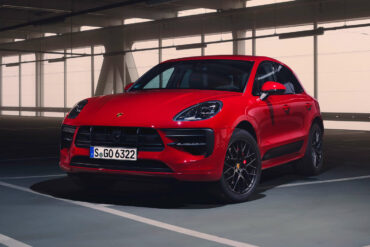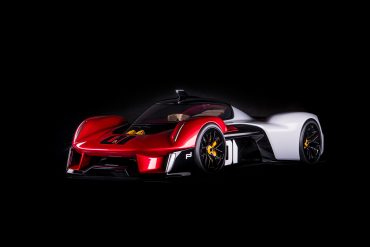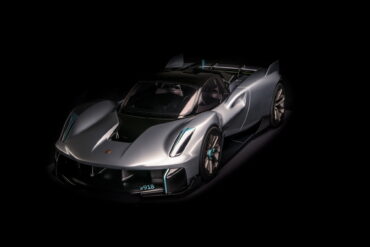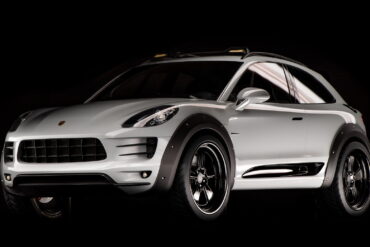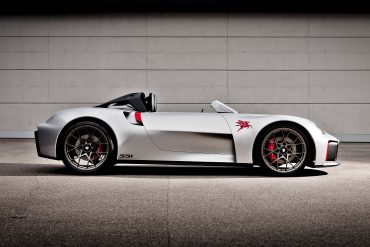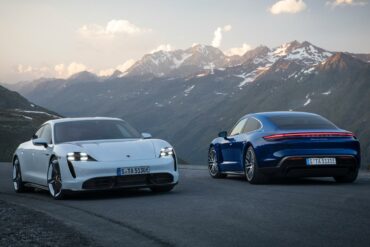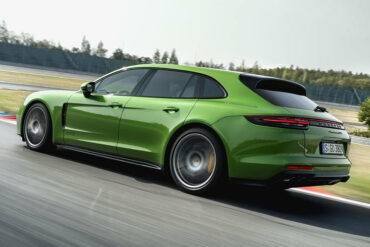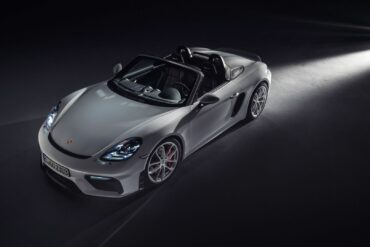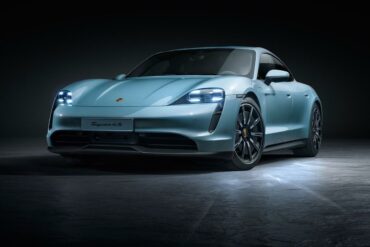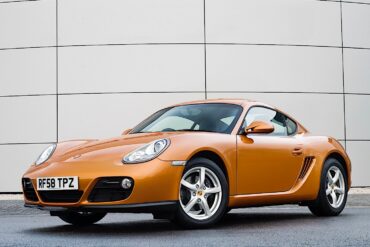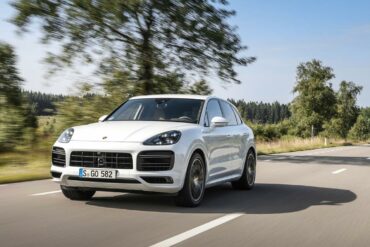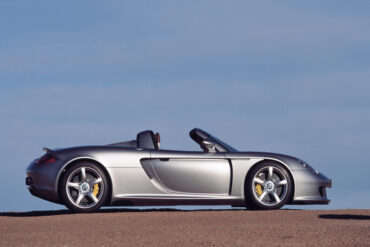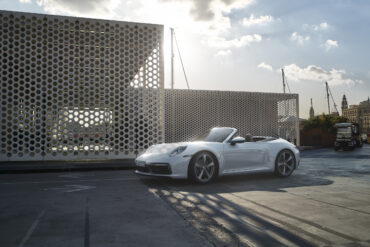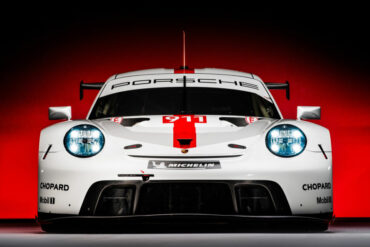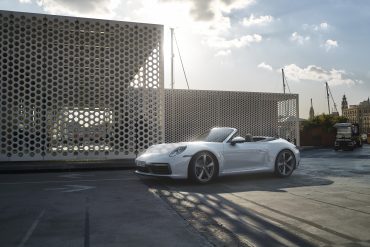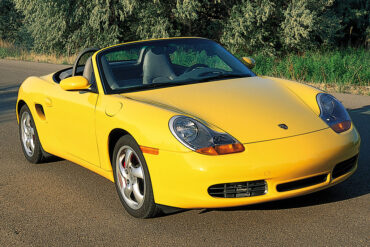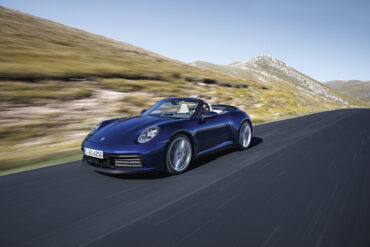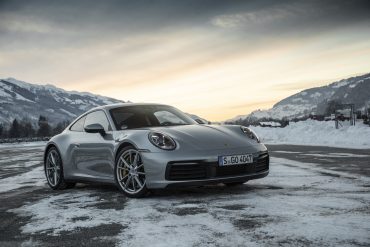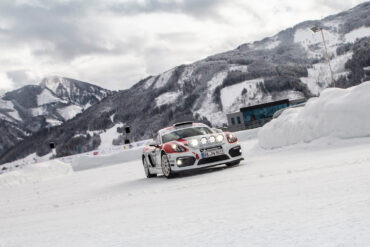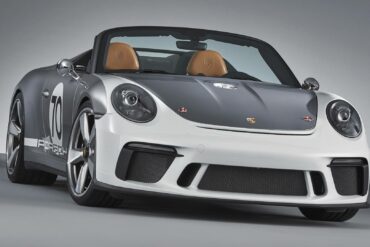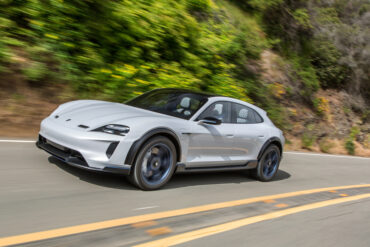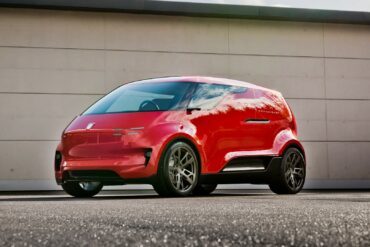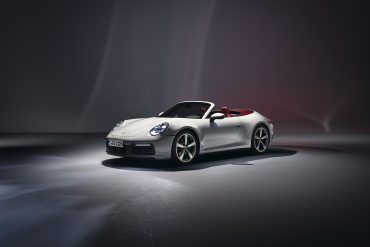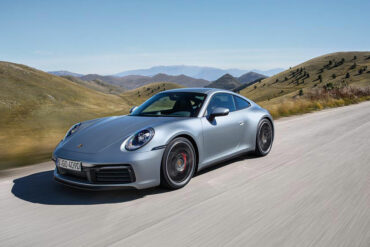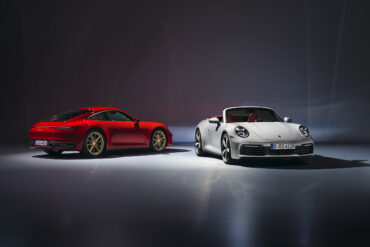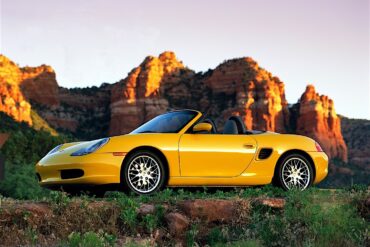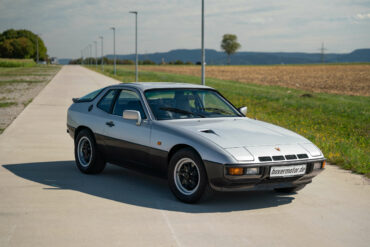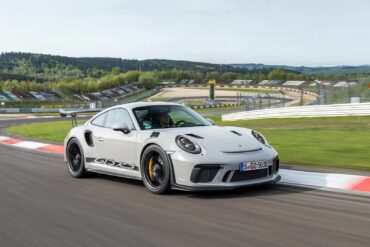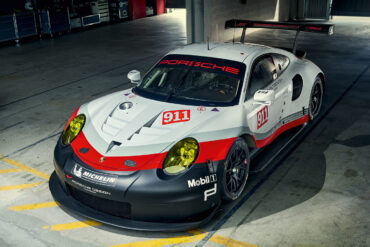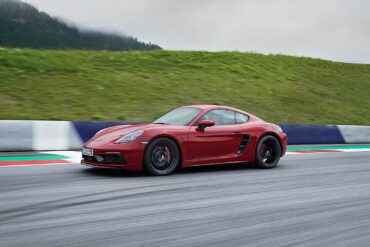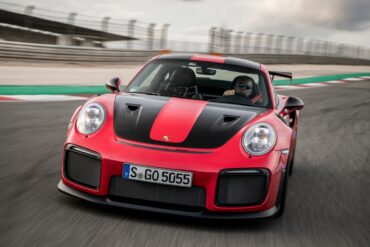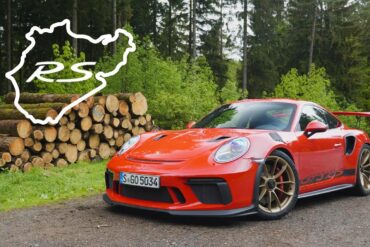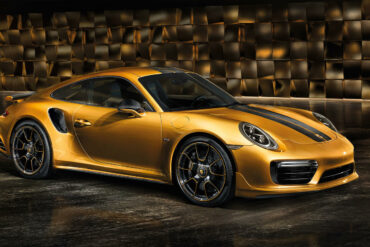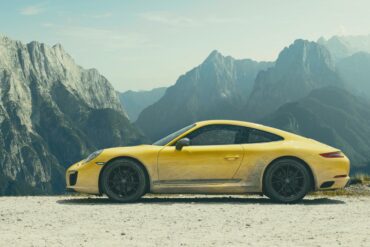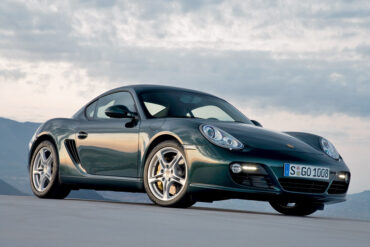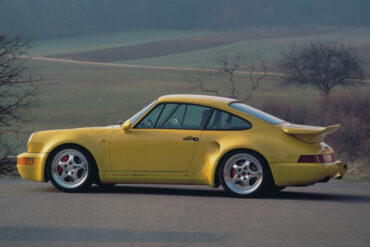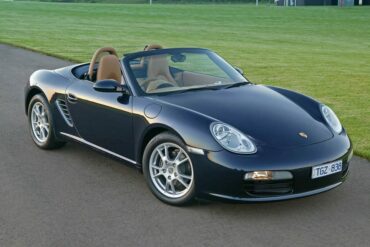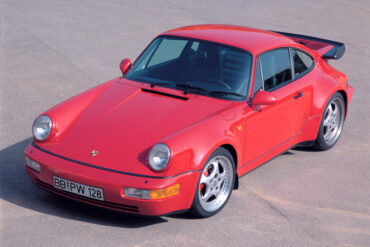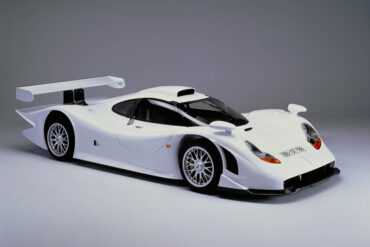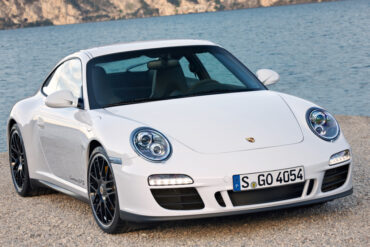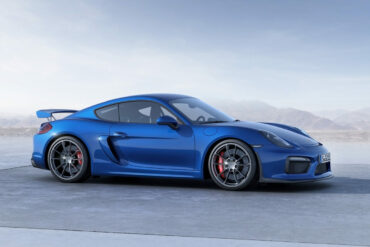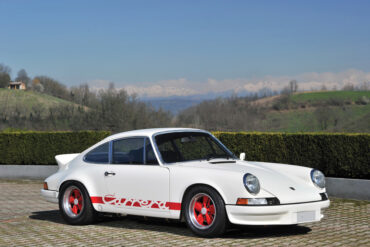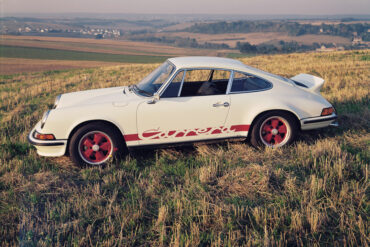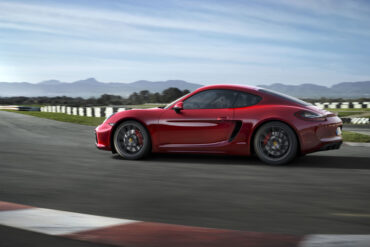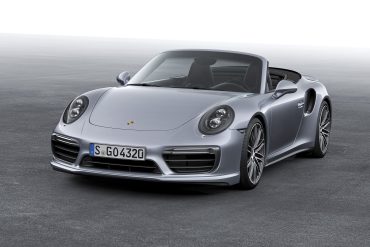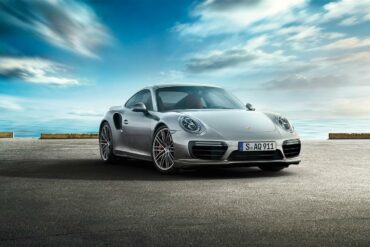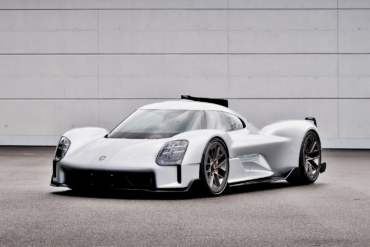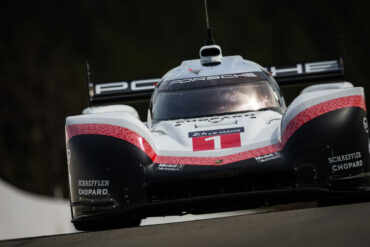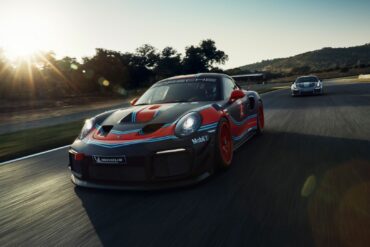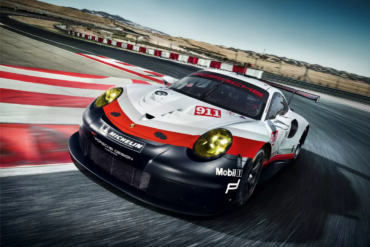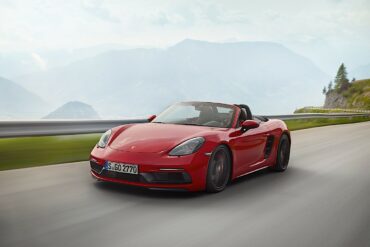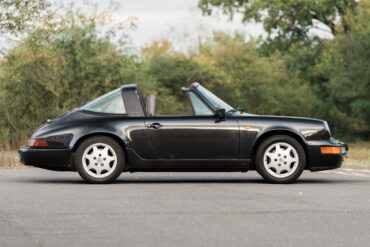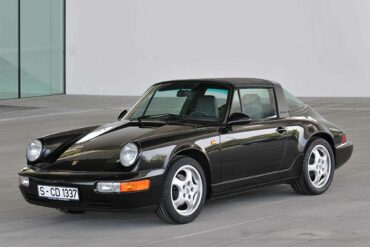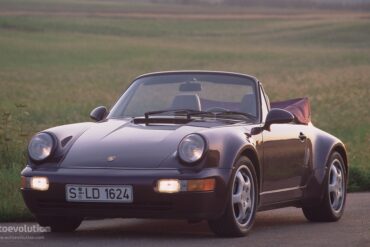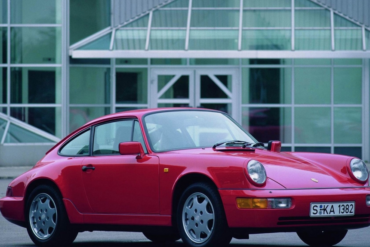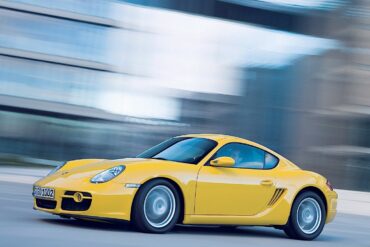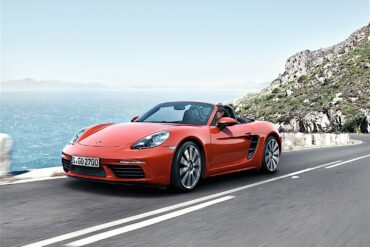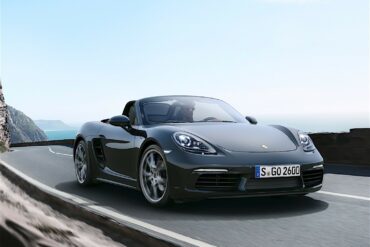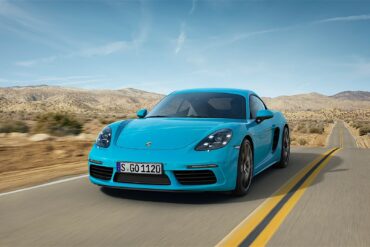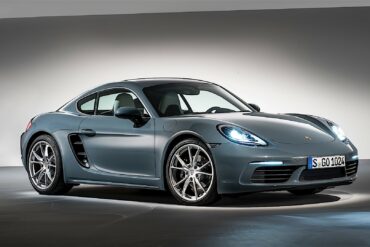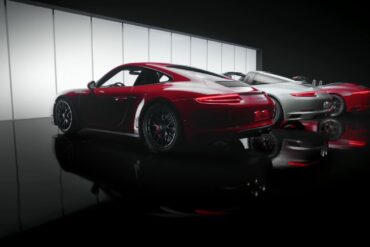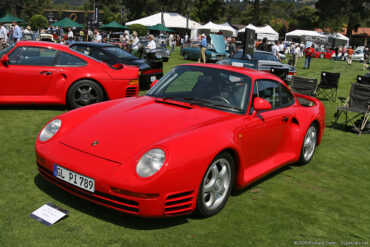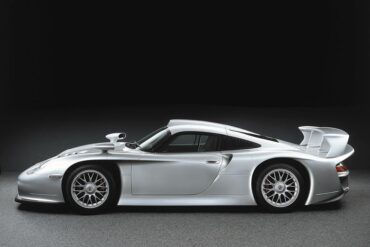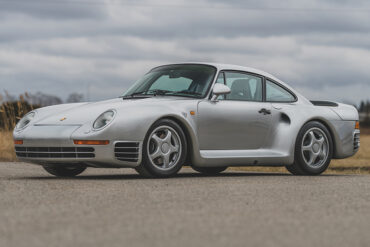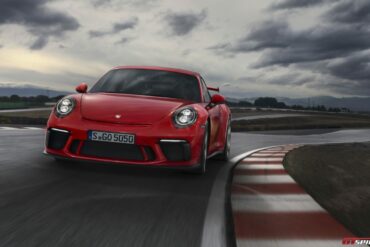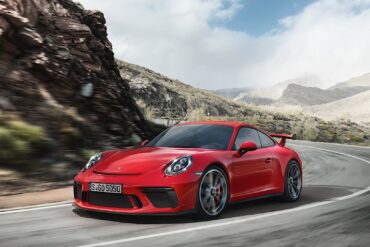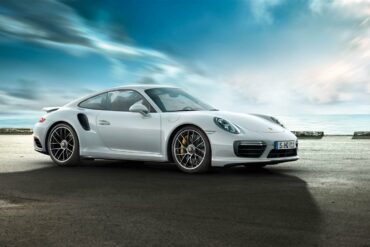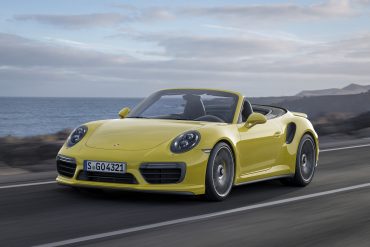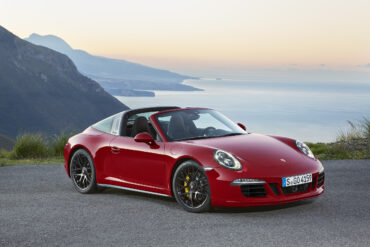Porsche shipped one of its experimental 'All-aluminum' 928S to the Brumos Racing Team for the 1984 24 hours of Daytona with the instructions not to modify the car in any way. Porsche desired to promote the performance of the 928 in the U.S. The drivers were given specific instructions to just 'drive the car'.
In collaboration with tuning company AMG, in 1986 Porsche created several long-wheelbase 928 specials. These models had normal 928 headlights until the Porsche 942. One was given as a gift to American Sunroof Corporation founder and CEO Heinz Prechter. The ASC was eventually part responsible for making Porsche 944 S2 cabriolets.
Porsche's Racing Department never officially entered or prepared a racing 928 for a pure works entry. In order not to offend sensibilities of their traditional 911 customers by openly challenging them with a Works 928GTR offering, Porsche asked Max Moritz Racing, their longtime private racing partner from next door Reutlingen to enter a 928GTR Cup as a 'semi-works' car.
With the engineering might (and budget) of Porsche behind it, and drawing upon the company’s experience of racing hybrids in endurance racing, the 918 Spyder managed to undercut its rivals on price, while providing arguably the most complete road car package of the holy trinity. Appropriately, 918 examples of the Spyder were promised, with Porsche digging deep into its motorsport knowledge to produce technology that provided world-beating performance.
This family car seats five, boasts generous cargo space, and will top out at an incredible 196 mph if the highway is long enough sans speed limits - think the German autobahn! For 2021, Porsche replaced the Panamera Turbo with the Turbo S variant with new design cues like the LED light strip between the taillights alongside some minor interior tweaks.
Essentially a Carrera 3.2 with a chopped, more steeply raked windscreen and hood, plus a stripped-out interior. Most had wide Turbo bodies. Porsche insisted that the simple hood was not designed to be 100 per cent watertight. The first Porsche 911 Speedster was built in 1989 and it was the last vehicle with the old 911 body. Three decades passed before the Speedster made a comeback. Had a 3.2 L Aircooled Flat 6 and 2274 were produced for the 1989 model year.
19 non 'slant nose' or Package cars were made for the USA only. Very rare. The Porsche factory had 93 Turbo chassis left. These were all transferred to Porsche Exclusiv and hand built as the very special 964 Turbo 3.6 S. They were offered with normal, or ‘Flachbau’ slant nose front ends. While the vast majority of Turbo S’ were fitted with the ‘Flachbau’ nose as a no-cost option, the Turbo S could also be had with the traditional 964 nose as well. In all, 76 Flatnose cars were made while 17 non-Flatnose (known as Package option) cars were made. These cars were also fitted with the X88 option, which increased power to 380 hp.
The Touring makes sense for those who envision their GT3 more as a daily mode of transportation than a track specialist (it can do both well). GT performance is good enough for any paved road but the Touring was created for a certain type of personality. There is no other car that can invoke a sense of connection and purpose like a GT3 Touring (with a 6-speed manual transmission) can. This is the car to buy and own forever.
The 992-era 911 GT3 confirms that Porsche is prepared to go to astonishing lengths to keep the hardcore faithful happy. The engine is a naturally aspirated 4.0-litre that revs to 9,000 rm and has little in common with the unit found elsewhere in the 992 range and a lot to do with the one in the GT3 Cup car. Power is up a modest 10bhp to 503 bhp, torque to 347 ft lbs. That’s more than enough. It’ll accelerate to 62mph in 3.4 seconds. It is the best sports car on the planet.
The Porsche 911 Targa 4S Heritage Design Edition showcases what is possible with Porsche's Exclusive Manufaktur program and what to expect from Porsche's Heritage Design Strategy. Inspired by the 356 and previous generations of the 911, Porsche's Heritage Design Strategy is bringing period-correct design cues into the current 992 generation 911. Cherry Metallic is the stunning color. Limited to just 992 units globally.
The GT3 R has always been placed between the GT3 Cup and the very expensive RSR. All the 991.2 racing cars have normally aspirated 4-litre engines. Compared to the 991.1 GT3 R, the 991.2 GT3 R engine offers a broader usable rev range and the engine response is more precise due to 6 throttle butterflies. The roof, front hood and fairing, wheel arches, doors, side and tail sections, rear lid and interior trim are made of carbon-fibre reinforced plastic. Gets new double wishbone suspension.
This was the fourth version of the 991 RSR - the first two came with the rear engine, then the first mid-engine version was launched (all 4.0-litre) and finally the mid-engined RSR 4.2 with the largest 911 engine ever made. The increase in the engine capacity is a question mark as on production models the capacities are decreased and turbochargers are used. The 991 RSR 4.2 didn't have anything in common with the production cars anymore. No change in terms of power-to-weight ratio.
Based on the 530-bhp 911 Turbo S, the special-edition Porsche has carbon-fiber trim inside and out, plus upgraded leather, badging and the exterior colors of the 918, including the use of Acid Green on the brake calipers, illuminated sill plates, interior stitching and instrument cluster needles. Also limited to 918 units, the 911 Turbo S Edition 918 Spyder will be available in Coupe ($160,700) and Cabriolet ($172,100) forms, making this one very expensive dealer option.
In 2011, Porsche China released a special limited edition model to celebrate an active decade in the Chinese market. The Porsche 10 Year Anniversary Edition is yet another 911 of only ten copies, each with a stylish plaque with the chassis number. The Porsche has a Gold Bronze Metallic paint, combined with matte black carbon components such as the hood, rear wing, tailgate and side mirrors. Underneath, you will spot a 911 Turbo S. The interior is a combination of black with gold stitching leather, alcantara and carbon.
Porsche 911 Turbo (992) Earlier this year, Porsche revealed and released the 2021 model year Type 992 911 Turbo S,...
991.1 Porsche 911 Carrera GTS (Ultimate Guide) The GTS is the fastest, most athletic model in the 911 Carrera line...
The Porsche 942 was a special edition of 928 submitted by the company as a gift to Ferry Porsche on his 75th birthday in 1984. Also known by name 928-4, 928S, it had an additional 254 mm wheelbase than the normal 928 production model, including an extended roof over the rear seats to better accommodate tall passengers, headlights very advanced technology, the motor 5 liter 32 valves before introduced to the U.S. market.
Like the standard 4S, the Targa 4S produces 443 bhp @ 6500 rpm from a six-cylinder, 3.0-litre boxer engine with twin turbochargers, and puts it to the road via an eight-speed PDK and Stuttgart's refined all-wheel-drive system. 390 ft lbs from as low as 2300 rpm also means you have tons of mid-range power on tap for any situation. Compared to the previous generation Targa 4S, the new model is up 23 hp and 22 ft lbs of torque.
While the base Targa isn't the most dynamic 911, it will suit a certain buyer well. If you want the sexiest looking 911 that is a great all-rounder and you don't plan on spanking it all the time, then this is a great 911 to buy. Even in lower-powered form, the 3.0-liter is a peach of an engine. Torquey across its rev range, it responds quickly to prods of the throttle. The real problem with the Targa is the added weight and the structure, which hurts it dynamically.
Engine based on modified 3.6 litre 964 unit. Speedline wheels with big red brake calipers. Lessons learned in the Carrera Cup series proved the reliability of the new 3.6-litre engine. An additional three millimetres on the bore and two millimetres on the stroke, resulted in an increase in capacity of 300 cc. Combined with the turbo optimised cylinders, pistons and crank train, and an increase in the compression ratio from 7.0 to 7.5:1, this helped to boost power to 360 bhp. Torque was increased significantly to 520 Nm at 4200 rpm, up from 450 Nm at 4500 rpm in the earlier car.
The two most powerful and fastest mid-engine sports models from Porsche are ready and raring to go: with uprated engines and excellent PASM chassis the Boxster GTS and Cayman GTS set new benchmarks for sportiness in their segment. 3.4 L naturally aspirated flat 6 is good for 330 hp. Sport Chrono package is standard. This means that in conjunction with the optional Doppelkupplungsgetriebe (PDK) and the active Sport Plus button, the Boxster GTS sprints from 0-100 km/h in 4.7 seconds.
In 1979, Porsche unveiled a concept version of the 924 at the Frankfurt Auto show wearing Carrera badges. One year later, in 1980, Porsche released the 924 Carrera GT, making clear their intention to enter the 924 in competition. By adding an intercooler and increasing compression to 8.5:1, as well as various other little changes, Porsche was able to develop the 924 Turbo into the race car they had wanted, dubbing it the "924 Carrera GT". 406 examples (including prototypes) of the Carrera GT were built to qualify it for Group 4 racing requirements.
All Porsche 911s are turbocharged these days but the Turbo model is something special. It gets the twin-turbo 3.7-liter flat six with tons of power and a huge $33,000 savings over the Turbo S. Thanks to an output of 573 hp, marking an increase of 32 hp over the predecessor, the new 911 Turbo Cabriolet accelerates from 0 to 60 mph in 2.8 seconds (0.2 seconds faster than before). The Turbo Cabriolet basically handles like a coupe.
It would be a disservice to call this new Turbo a "lesser" car than the Turbo S, but it does have less in most departments. Less power at 573 HP. Less features compared to the jam-packed Turbo S. Most importantly, less money required to put one in your garage. This also is not to say that the new Turbo isn't anything short of a monster. It will still go 0 to 60 in 2.8 seconds, will corner like it was on rails with Porsche Torque Management (PTM) all-wheel-drive.
The 2022 Porsche 911 Turbo S Cabriolet is a formidable beast. The new Turbo S comes with an all-new, 3.8 liter boxer six with two variable turbine geometry (VTG) turbochargers. The power output is a staggering 640 hp and 590 lbs-ft of torque. In keeping with previous Turbo models, the engine powers all four wheels. A new 8 speed automatic transmission with a manual mode manages the power, and can power the car to 60 mph in a hair under a claimed 2.7 seconds.
The current Turbo S comes with an all-new, 3.8 liter boxer six with two variable turbine geometry (VTG) turbochargers. The power output is a staggering 640 HP and 590 lbs-ft of torque. In keeping with previous Turbo models, the engine powers all four wheels. A new 8 speed automatic transmission with a manual mode manages the power, and can power the car to 60 MPH in a hair under a claimed 2.6 seconds. This is a staggeringly quick and capable car.
The Porsche Vision E is a race car concept, designed and built by Porsche in 2019, to preview what essentially would be a future customer race car from Porsche. Using technology from their Formula E race car, the Porsche 99X, the company says that this concept would preview what would be a race car that private individuals can drive, to get the closest feel to Formula E in terms of performance and driving dynamics.
The Audi SQ5 Had Better Watch Out Porsche has more competition than ever before for its SUVs. The 2020 Porsche...
The Porsche Vision 920 is a race car concept, designed and built by Porsche in 2019, to preview what essentially could be a successor to their highly successful LMP1 race car, the Porsche 919 Hybrid. Porsche says the company designed the concept as either a super sports car for the road or as a possible racing car that could be used in a customer motorsport series.
The Porsche Vision 918 RS is a supercar concept, designed and built by Porsche in 2019, to preview what essentially could be the next generation of a trackday, street-legal Porsche 918 if it were still in production. Some of the design elements, none of which bear resemblance to the original Porsche 918, include sharp and soft creases and large air intakes, three fins on the widened rear fenders and roof.
The Porsche Macan Vision Safari is a 3-door compact SUV coupe concept, designed and built by Porsche in 2013, essentially showing what would be an off-road Porsche Macan. The concept only had two doors compared to the four in the normal SUV, and came with a host of off-road-oriented accessories, some of them including an increased ride height, larger front and rear tires.
The 551 Vision Spyder was built in 2019 but kept a secret until its unveiling this week. Billed as a 21st century reimagining of the 1954 machine that made Porsche’s name, in fact it’s really an hommage to one particular car, James Dean’s Little Bastard, wearing the race number 131 (Dean’s was 130) and the licence tag “Little Rebel”.
It is expensive, it is fast and it is exceptional. The Porsche Taycan Turbo shows us that Porsche's electric future is going to be great for drivers. The Taycan Turbo feels even relentlessly rapid at any speed and the best part is that it really feels like a Porsche from behind the wheel. The Turbo has the same 93.4kWh battery stack as the Turbo S, and the same 614bhp power output. But when you’re going for it in Performance mode, the Turbo’s overboost power and torque are reduced compared with the Turbo S. It means the Turbo is four-tenths slower to 60 mph from standstill.
For the 2019 model year, the second-gen Panamera is now a beneficiary of the badge - which actually stands for ‘Gran Turismo Sport’ - that has come to represent the pragmatist’s choice of Porsche automobile. The Panamera GTS is also now available in a long-roof wagon body style, dubbed the Sport Turismo. In totality, this is the vehicle I will be writing about - the 2019 Porsche Panamera GTS Sport Turismo. Traditionally speaking, the GTS version of any Porsche has typified a “sport-plus” version of a mid-level trim within the model range.
The 718 Boxster Spyder is everything you could possibly want in a sports car. The sublime combination of a legendary chassis and naturally aspirated 6-cylinder Porsche engine is accentuated by the emphasis that less is more when done right - and nobody does this better than Porsche’s GT division. Connections with these cars are visceral and emotional, an outcome mutually desired by both Porsche engineers and customers alike. They will never be considered tardy in the right hands. The Spyder is in my opinion, the best sports cars you can buy in this segment.
The Taycan 4S is the more affordable version of the four-door electric car, but it still offers impressive performance and a high price tag. The Taycan 4S is the sweet spot for Porsche's electric four-door sports car, with more than enough performance for daily driving and enough equipment to feel like it is worth the money. The 4S makes a total of 522 horsepower with its base 79.2-kWh battery pack and 563 horses with the optional one, the 93.4-kWh Performance Battery Plus. Porsche claims a zero-to-60-mph time of 3.8 seconds for the 4S.
Four years after the introduction of the Cayman S, and three after the regular Cayman, the mid-engine sport-coupe from Porsche received an important update. The facelifted version of the Cayman offered a completely enhanced package. From the exterior to the interior, from the engine to the gearbox and suspension, it was reworked. It might be mistaken with a new model if the Porsche internal coding system wouldn't be the same as on the 2006 Cayman (987C). The engine displacement was increased from 2.7 to 2.9-liter and received direct fuel injection.
More Powerful Than Most 911s We’re pretty firm believers that sports cars are always going to be more enticing than...
Porsche Carrera GT Contents Chassis & Handling Design, Styling & Interior Pricing Performance & Specs Model & Pricing Info Suspension...
Features like Porsche’s active suspension and the new-for-992 “wet mode” are standard on the Carrera 4 variants, but the electronically controlled limited slip rear differential (standard on the 4S), as well as ceramic composite brakes (cast iron rotors are standard). The current 911 Carrera 4 Cabriolet is equipped with PASM (Porsche Active Suspension Management). The twin-turbo flat-six has 379 hp and 331 ft lbs of torque.
Improving a Car That’s Already Excellent The Porsche 911 RSR is a car that has won more than 20 FIA World...
The Carrera 4 is the base model 911, equipped with all-wheel drive. It starts at $109,850 for 2022, which is about $7,000 more than the standard rear-drive Carrera. Other than the additional all-wheel-drive system and the 150 odd pound increase in curb weight, the Carrera 4 is identical to its rear-drive sibling. It gets the same 379-hp, twin-turbo 3.0-liter flat-six engine. The twin-turbocharged 3.0-liter flat-six has 379 hp.
Make no mistake that the Speedster is an absolutely fitting conclusion to the 991-generation. The Porsche 911 Speedster is an ingenious amalgamation of the latest technologies on offer, and the more simple ingredients that have been a principle of driving enjoyment since the invention of automobiles. A 502-horsepower engine, without turbochargers. A modern transmission, with just one clutch. A state-of-the-art suspension and chassis, with an unsullied purity. The list goes on. Perhaps the only drawback is that the Speedster’s rarity and price.
In 2000, Porsche gave us the Boxster S. With a 3.2 liter naturally aspirated Flat-6, it was good for 250 bhp and 225 ft lbs of torque, up by 25% on the base 2.7 liter Boxster. Hardward changes, a 6-speed gearbox and all this extra power and torque transformed the Boxster driving experience. From behind the wheel, the Boxster S rushes forward in a way that is missing from the base model, that torque increase really making itself known, especially in the midrange. 0 to 60 mph now takes 5.60 second (compared to 6.5 for the 2.7 L base model). Top speed is 161 mph and the quarter mile is 14.1 seconds.
Top down summertime driving in the current 911 Carrera 4S Cabriolet is about as good as it gets. It checks all of the right boxes, as while it has matured into almost a GT-type car; it still boasts more performance than ever. Like the rest of Carrera S models, the Carrera 4S Cabriolet is powered by the same 3.0-liter twin-turbo flat-six that makes 443 horsepower and 390 ft lbs of torque. It comes standard with the same eight-speed twin-clutch automatic transmission.
The perfect daily driving sports car with an all-weather, remarkably high-performance envelope. Like the rest of Carrera S models, the Carrera 4S is powered by the same 3.0-liter twin-turbo flat-six that makes 443 horsepower and 390 lb-ft of torque. It also comes standard with the same eight-speed twin-clutch automatic transmission with the same gear ratios, except the 4S with an added clutch and differential up front.
On 3 January 2019 the 718 Cayman GT4 Clubsport was unveiled in two variants, Competition and Trackday, with first customer cars delivered to customer teams ahead of the 2019 Roar Before the Rolex 24 Hours at Daytona International Speedway. The race car is powered by a 3.8-litre naturally-aspirated flat-six engine producing 425 PS (419 bhp; 313 kW) at 7,500 rpm and 425 N⋅m (313 lb⋅ft) at 6,600 rpm connected to a 6-speed PDK gearbox. The kerb weight is 1,320 kg (2,910 lb). Both variants feature a welded-in roll cage, a six-point harness and race bucket seat, a selection of body parts made of natural-fibre composite materials and race suspension from the 911 GT3 Cup.
Porsche plans to return to rally racing with a 718 Cayman GT4 Clubsport R-GT Rallye. The car came about because of the positive response Porsche received on a rally car concept that it sent out into the world. Before the official car comes, Porsche did some testing with its 718 Cayman GT4 Clubsport-based concept race car. The company let racing legend Walter Röhrl get behind the wheel at the GP Ice Race in Austria.
Porsche is celebrating their 70 years in the making with the Porsche 911 Speedster Concept car. With the Carrera Cabriolet 4 body as its canvas, the Speedster concept pays homage to its predecessors - most notably, the Porsche 356 1500 Speedster. The limited production Speedster is immediately distinguishable from the current 911 line-up, with its “double bubble” tonneau cover and other unique offerings and design tweaks.
The Mission E Cross Turismo concept is a more outdoorsy activity-wagon version that was first displayed at the 2018 Geneva motor show. This concept was built as a drivable car. Porsche essentially took the Mission E project’s hardware in development, so it serves as a snapshot of where things stood about two years into a five-year program.
The Porsche vision “Renndienst” (2018; 1:1 hard model) is the free interpretation of a family-friendly space concept for up to six persons. The design team designed a futuristic “space shuttle“ with exciting proportions. The study shows how the Porsche design DNA with its characteristic surface modeling can be transferred to an unknown vehicle segment for the brand.
The Porsche 911 Carrera S Cabriolet also features a heated glass rear window and integrated magnesium support elements. The automatic fabric top opens and closes at speeds of up to 31 miles per hour in just 12 seconds – one second quicker than before. The 992 Carrera S Cabriolet gets a twin-turbo 3.0-liter flat-six with 443 bhp and 390 ft lbs of torque. That is 29 more horsepower and 22 more ft lbs of torque than the outgoing model.
If the base 911 coupe doesn't do it for you, maybe the Carrera S coupe gets you over the line. For about $20k more, you get more horsepower, torque vectoring and bigger wheels. The Carrera S uses a version of the 3.0L twin-turbo flat-6 that generates 443 hp and 390 lb-ft of torque. Torque vectoring allows different amounts of torque to be distributed between drive wheels on the same axle. This means the inside wheel can turn slower than the outside wheel for improved cornering.
Removing the roof the car is supposed to have little impact on its chassis stiffness and curvy road prowess, but Porsche tells us that the current generation 911 Cabriolet drives just as well as the coupe. Powering the base Cabriolet is the same impressive turbocharged flat-six engine that makes 379 bhp @ 6500 rpm and 331 ft lbs of torque. The base cabriolet can do the 0 to 60 mph run in 4.2 seconds flat. With the optional Sport Chrono Package that drops to 4.0 seconds.
The most basic version of the Porsche 911 Carrera has now been unveiled. Porsche chose to detune the twin-turbocharged flat-six engine and downgrade some of the chassis components. These cars offer very good performance and driving dynamics for a slightly lower price. While marginally larger and heavier than the 991-generation model it replaced, the 992 is also more advanced. Power climbs by 15 bhp from the 991 Carrera, to 379 bhp @ 6500 rpm, which is more than enough horsepower for the street.
While the original 986 Boxster was a sweet ride, its performance began to lag behind newer competitors like the Honda S2000. Powered by a 2.5-litre flat six-cylinder engine, the base model was upgraded to a 2.7-litre engine in the year 2000. The gearbox options in the Boxster 2.7 are the same as in 2.5, but they got new type designations due to improvements. Externally, the 986 Boxster 2.7 looks like Boxster 2.5. Inside the side airbags are standard and the plastic feeling has been reduced. The fuel tank is a larger 64-liter. Alcantara trim is available on the options list.
Porsche upgraded the performance of its 924 with the introduction of a turbocharged model in 1979. While the lower end of the engine remained unchanged, many improvements were made to the upper end of the engine as well as the drivetrain. On the outside, the car gained alloy wheels, a distinctive NACA duct in its hood, and a rear spoiler. Horsepower increased from the naturally aspirated 125 bhp to 170 bhp in the turbo.
Matt Prior from Autocar nails the 991.2 GT3 RS: “While I don’t think the 3 communicates any better than a 2, the messages it does transmit are superior: you can feel that it’s lighter, more willing to turn, easier and more satisfying to ease onto the throttle and keep it pinned. It’s why this car is only a few seconds slower than a 2RS around the Nürburgring Nordschleife despite being almost 200bhp down.” He goes on... “And in the form of the GT3 RS it goes into creating - little by little, detail by detail - what might just be the best driver’s car currently on sale.”
Yes, It’s For Sale…. However, the allocation for MY2018 units was already spoken for before this calendar year – all...
Porsche expanded its mid-engine range with the new two-seater Porsche 718 Boxster GTS and Porsche 718 Cayman GTS. The vehicles' power has now been increased to 269 kw (365 hp) thanks to a newly developed intake duct and an optimised turbocharger for the 2.5-litre, four-cylinder boxer engine. With these improvements, the engine delivers 11 kW (15 hp) more power than the 718 S model and up to 26 kW (35 hp) more power than its GTS predecessor models with naturally aspirated engines. The new mid-engine sports cars are available with manual six-speed transmission or optional PDK
The GT2 RS's reputation as the most powerful street-legal car is as monstrous as this comprehensive guide. Suffice to say, this supercar has been built with the best Porsche has to offer. It's not bragging, it's just facts. There is no doubt that the new GT2 RS is the pinnacle of the 911 in terms of performance. It is simply the fastest 911 in history, and that’s a fact. It is the quickest production car to lap the Nürburgring Nordschleife. It is the most powerful 911 ever made.
Henry Catchpole drives the 991.2 Porsche 911 GT3 RS in search of the forgotten Sudschleife circuit....
The 500 hundred numbered 911 Turbo S Exclusive Series cars cross the 600 hp mark with their 446 kW engines. The power increase does not make much difference performance wise, but it is good to know you have more than 600 hp. Similar in acceleration and top speed to the ‘regular’ Turbo S, the car reaches 200 km/h (124 mph) in 9.6 seconds (0.3 seconds faster than the regular Turbo S). The car comes standard with the Turbo Aerokit and roof panel made of carbon-fibre reinforced plastic.
To the untrained eye, the Carrera T may appear to be a bare-bones and sparingly equipped 911 at first glance. The purpose of the T is to create a driver-focused 911, equipped with only the necessities required to appeal to those of a purist’s ilk. The Carrera T employs the same power plant used in the current base Carrera - a twin-turbocharged 3.0L flat-six with 370 horsepower and 331 lb-ft of torque. A 7-speed manual transmission comes standard with the T, along with a shorter final-drive ratio and the limited-slip differential. Porsche Sport Exhaust (PSE) is also standard. PASM sport suspension comes standard in the T, which lowers the chassis by 0.4 inches relative to the base Carrera and allows for two modes of dampening.
Four years after the introduction of the Cayman S, the sportier version of the mid-engine sports coupe Porsche was refreshed. It was even faster and could carry more cornering speed. The facelifted version of the Cayman S offered a completely enhanced package. From the exterior to the interior, from the engine to the gearbox and suspension, it was reworked. The engine was kept at 3.4-liter displacement, but due to its new direct-fuel injection system, the power was increased by 25 hp over its non-facelifted version.
Porsche made a lightweight version of the Turbo simply known as the Tuubo S. This used the spartan appointments of the Carrera RS with an upgraded version of the Turbo engine. Some cars received graphics on the side celebrating IMSA Supercar Championship. Similar to the Carrera RS, the Turbo S had no power steering, air conditioning, airbags, central locking, alarm system, rear window wiper, smaller window washer reservoir, smaller horn, and had thin-gauge glass. The engine used a second oil cooler and slightly higher boost to improve overall performance.
The 2007 model year Boxster got a change that most people don't think is significant, but is. Model year 2007 is when the base Cayman joined the 987 lineup. The interior and exterior remained mostly the same, but the Boxster S received the Cayman S 3.4-liter flat six while the 2.7 in both the Boxster and new Cayman received VarioCam Plus, which bumped horsepower up to 245. Think of this model year as Porsche taking the changes to get the base Boxster 2.7 to the same level as the recently introduced base Cayman.
The 1989/90 change of model year saw the launch of the Porsche 911, 964 series onto the market. This 911 model was initially available as a Coupe, Targa and Convertible. From model year 1991 onwards Porsche also introduced its top-of-the-line model - the Turbo - into this series. In spite of bearing a major similarity in terms of look to the naturally-aspirated model, the extended wings remained. This meant that the new Porsche could retain its turbo look. The 964 Turbo model was the successor to the Porsche 930. The 964 Turbo was the end of an era, the last of the single turbo rear-wheel drive 911 Turbos.
A single car - the 911 GT1-98 Straßenversion - was built in 1998 to homologate the all-new racing version under the new FIA regulations. The engine had to be slightly de-tuned to meet European emissions laws, although its 400 kW (544 PS; 536 hp) at 7,200 rpm and 600 N⋅m (443 lb⋅ft) of torque at 4,250 rpm proved to be more than adequate; the car could accelerate to 100 km/h (62 mph) from a standstill in 3.6 seconds on its way to a top speed of 193 mph.
It's not often Porsche creates an all-new model in their 911 lineup. But the 997 Carrera GTS is just that. It's faster, more powerful and better looking than any other model in the Carrera family. However it's still a little less hardcore than the 911 GT3, and a lot cheaper than the 911 Turbo. The Porsche 911 Carrera GTS features a 3.8 litre flat-six engine which is tuned to develop 408 horsepower, that's 23 hp more than the Carrera S manages. Think of it as the perfectly optioned Carrera S for less money.
In 2015, Porsche announced the car we all thought Porsche would never build. It has been a few years since it has been released and the excitement It was the first time Porsche introduced lets the motorsports guys in Weissach sprinkle their magic on a Cayman. With components sourced from the 911 GT3, an engine carried over from a Carrera S and a tweaked and tuned chassis, brakes and aerodynamics, Porsche’s engineers did their best to produce the perfect mid-engine sports car for road and track use. Compared with the standard Cayman, the GT4’s chassis was lowered by 30mm and bigger brakes were added, with many aspects of its suspension carried over from the 911 GT3. Some serious motorsport kit. One of the best ever.
Of all the 1580 Carrera RS 2.7s, only 200 were made were ordered with this lightweight ‘Sports’ trim which made the car more responsive and purposeful. In many ways these few cars were the ultimate road-going Porsche of the 1970s. Known as the Sports, Lightweight or even the M471 option code, these cars had improved the power-to-weight ratio. Reports of 75kg were stripped from the standard model by fitting lightweight body panels and lightweight glass.
Revealed at the 1972 Paris Auto Show, the Carrera 2.7 RS was a special model used to homologate the 911 in Group 4 racing. Developed from the 911S, the 2.7 was more potent in almost every area. Compared to the standard Carrera, the 2.7 RS featured a larger engine, wider flares to accommodate the Fuchs alloy wheels, stiffened suspension, larger brakes and a ducktail rear spoiler. The Touring outsold the Lightweight, with a total of 1380 units built (the Lightweight had only 200 units).
The Cayman GTS arrived a s 2014 model year car and boy was it special. It featured a marginally more powerful engine, a new body kit, new 20-inch Carrera S wheels, new Bi-Xenon headlights, and a new sports exhaust system. The Cayman GTS is longer than the Cayman and the Cayman S by 30.5 mm (1.2 in) due to its bumpers. The new, optional passive sport suspension allows the Cayman GTS to have a 20 mm lower ride height compared to the Cayman equipped with standard passive suspension or 10 mm lower compared to one with the standard-equipped PASM. Power was 330 bhp @ 6700 rpm and 0 - 60 mph was a brisk 4.1 seconds.
The Cabriolet version of the 991.2 Turbo got the same updates as its coupe sibling. The engine in the 991.2 911 Turbo Cabriolet is a twin-turbocharged flat-six with 540 horsepower and 523 pound-feet of torque, up a decent 20 more horses versus the 991.1 Turbo Cab. Improvements that come from increases in boost and fuel-injection pressures. Rounding the skidpad, the Turbo posts 1.02 g’s relatively easily. The wide P Zeros in back and the standard four-wheel steering conspire to hide the fact that 62 percent of the Turbo’s 3656 pounds sits over the rear wheels. 0 - 60 mph is over in just 3 seconds.
At the heart of the 991.2 911 Turbo is a twin-turbocharged flat-six with 540 horsepower and 523 pound-feet of torque. That’s a meaningful 20 more horses than the 991.1 Turbo. Improvements that come from increases in boost and fuel-injection pressures. Rounding the skidpad, the Turbo posts 1.02 g’s relatively easily. The wide P Zeros in back and the standard four-wheel steering conspire to hide the fact that 62 percent of the Turbo’s 3656 pounds sits over the rear wheels. With sport-plus selected, the 991.2 Turbo hits a 1.0-second run to 30 mph and a 2.6-second zero-to-60 time.
The Porsche 919 Street is a supercar concept, designed and built by Porsche in 2017, based on the highly successful Porsche 919 Hybrid LMP1 race car. The dimensions and basic design elements of the 919 Street are the same as that of the race car. However the 919 Street instead has a less-pronounced wing and more street-car comforts. This is the one we wish they made. Alas, the 900 HP LMP1-Based road-ready rocket that never was.
With the car retiring after the 2017 LMP WEC season, the Porsche team decided to throw it a truly memorable send-off. Freed from any restrictions brought upon by strict regulations in the class it competed in, Porsche threw out the rulebook and established a new benchmark. Amongst the notable parting gifts was a significant horsepower bump, increasing the turbo V4 to 720 horsepower from 500 horsepower. Additionally, the electric motor received a 10% boost, now generating 440 horsepower. In total this gave the 919 a remarkable 1160 horsepower.
This car was officially called as the 911 GT2 RS Clubsport, but the name is rather misleading. The car was not built for the GT2 racing class which is long extinct and club sport has stood for Porsche club track days while this non-streel-legal car is a real racing car. Finally, the car was based on the 991 GT2 RS, which already had the Clubsport version. So, in order to understand what is what, we call it "991 GT2 RS Clubsport racing version". The 991 GT2 RS engine with 515 kW was powerful enough, so it was not tuned.
Two decades after the different 911 GT1 cars the mid-engined 911 is back! In order to install a proper diffuser under the rear end of the 991, the engine had to make room for it and the engine/transmission unit was rotated 180 degrees. The extended rear diffuser, a top-suspended rear wing and the new side mirrors help to increase downforce with reduced drag. The FIA rules meant no turbo was needed due to power limits, so the normally aspirated 4-litre flat-6 was taken from the 991 GT3 R.
In true Porsche GTS spirit, the output of the 2.5-litre, four-cylinder flat ‘boxer’ engine has been increased to 360 bhp courtesy of a new intake system and an optimized turbocharger. These improvements generate 15bhp more power compared with the 718 S model, and up to 35 bhp more power than the prior GTS models. A manual six-speed gearbox is standard, with the Porsche PDK available as an option. Standard equipment includes the Sport Chrono Package, Porsche Torque Vectoring (PTV) with a mechanical rear axle limited slip differential and Porsche Active Suspension Management (PASM).
Like the Carrera 4, the Carrera 2 was available as a coupé, Targa or Cabriolet. This was the last generation Targa with traditional removable Targa roof (till 991). It sold ok, with 3,534 units sold over its lifetime. The engine was the 3.6 liter unit which produced 250 horsepower and a maximum speed of 162 mph while the 0 to 60 mph acceleration was made in about 5.6 seconds. Performance was on par with the coupe and it is the looker in the 964 range.
This was the last generation Targa with traditional removable Targa roof (till 991). The Carrera 4 Targa outsold the Carrera 2 Targa by 2x, making the 4 Targa much rarer and more collectible. In all, only 1,329 units were made. Overall, the Carrera 4 packed almost the same technical specifications as the Carrera 2 model. The Targa top was quite a project to take off (compared to the simple and fast cabriolet process) so be prepared to garage it all the time or spend 20 minutes every time you want to enjoy open top fun.
Porsche added the rear wheel drive Carrera 2 variant to the range in 1990. It was developed alongside the 964 Carrera 4, Porsche waited a year to release the Carrera 2 as a 1990 model year car. Like the Carrera 4, the Carrera 2 was available as a coupé, Targa or Cabriolet. Think of the cabriolet as a C2 coupe but with a fabric roof and more fun and you are right on the money. It was popular amongst buyers, particularly in the United States, with a total of 11,013 units sold, making it the third most popular 964 model.
Porsche added the rear wheel drive Carrera 2 variant to the range in 1990. It was developed alongside the 964 Carrera 4, Porsche waited a year to release the Carrera 2 as a 1990 model year car. Like the Carrera 4, the Carrera 2 was available as a coupé, Targa or Cabriolet. Overall, the Carrera 2 packed almost the same technical specifications as the Carrera 4 model. The engine was the same 3.6 liter unit which produced 250 horsepower and a maximum speed of 162 mph. Looked like C4 but was 200 lb lighter and more fun to drive.
Porsche is the most successful marque in the 24 Hours of Le Mans and British drivers have played an important role in delivering these historical achievements, and in celebration of this success a special limited edition model – the 911 Carrera 4 GTS British Legends Edition was created. Designed by the drivers who took wins in the 24 Hours of Le Mans for the factory team – Richard Attwood (winner 1970), Derek Bell MBE (winner 1981, 1982, 1986, 1987) and Nick Tandy (winner 2015) – this model was developed by Porsche Cars GB and Porsche Exclusive Manufaktur.
A year after the Cayman S and the second generation of the Boxster were unveiled, Porsche released the non-S version of its mid-engine sport-coupe vehicle. The “regular” Cayman was still a sports car that could top a 0 to 100 kph (0-62 mph) in 6.1 seconds so it couldn't be called a “slow” car. It was slower than its brother S, but it was still a daily-driver sports-car. The Cayman was built to be not only a fast and nimble car but a practical vehicle as well.
While the first generation Boxster S was received with mixed feelings, the second generation was praised. With the introduction of the 718 Boxster, the car-maker showed a special commitment to the smallest member of the Porsche family and it arguably become the best sports car in the world. The Boxster S featured a 2.5-liter flat-four engine. It was turbocharged and with direct fuel injection and was good for 345 hp. Performance was up a lot, especially in the midrange, now that torque was 310 ft lbs. It helped rocket the Boxster S from zero to 60 mph in just 4.0 seconds and onto a top speed of 177mph.
Welcome to the four generation Boxster. The base Boxster was powered by a twin-turbo 2.0-liter direct-injection gasoline unit. It offered a total output of 300 hp and it was paired as standard with a 6-speed manual, while a 7-speed automatic (PDK – dual-clutch) was on the options list. In terms of design, it gets a more modern look and feel and the interior is upgraded. More tech, more power and more speed. The only downside is the loss of the aural pleasure of a flat 6 engine that is naturally aspirated and loves to rev to the sky.
Searching for more muscle? The 718 Cayman S got a new 2.5L turbocharged boxer 4-cylinder. Power comes in at 345 bhp @ 6500 rpm and torque is a really strong 310 ft lbs @ 1900 rpm. For reference, the outgoing 981 Cayman S had 311 bhp and 265 ft lbs of torque. While we hate the drone of the turbo four cylinder, there is absolutely no doubt that is much more powerful and that performance numbers are much stronger. 0 – 60 mph is over in just 4.0 seconds and the quarter mile is finished in 11.9 seconds flat. Much faster than the outgoing model. But is it as engaging? No.
With the 982-generation Boxster/Cayman platform, Porsche went back in time to pull out the 718 name, a reminder that the sports car maker has been doing the small sports car thing for a long time. The 718 of course, is diminutive race car that won the Targa Florio race in 1959 and 1960. The marketing stunt was meant to evoke these past Porsche racing successes with light cars like the 718 that outmaneuvered competitors with larger and more powerful engines. The reason? Porsche got rid of the naturally aspirated flat-6 engines and instead would now have flat-4 turbocharged engines.
A design that demonstrates sportiness in every fibre. A chassis equipped for any challenge. And a twin-turbo horizontally opposed engine...
For some context, the iconic 959 remained Porsche’s fastest production car for a cool 26 years (in its very rare S guise) before the company topped it with the 918 Spyder in 2013. Details on the 959 S are scarce; Porsche made just 29 examples of it, with the 2.8-liter flat-six engine featuring larger turbochargers and the company claiming an “official” output of 508hp and 413lb-ft of torque, over the standard 959’s 444hp. Top speed was 210mph.
Homologated roadgoing version of the ’97 911 GT1 Evolution racer costing $890,805 upon release. Twin-turbochargers were fitted to the M96/80 engine, which had water-cooled cylinder heads. Apparent from the front and rear lights, the GT1 shares many components with its series production counterparts, but puts them together in a more competitive way. Gone is the rear engine layout which isn't suitable for prototype GT racing, the GT1's turbocharged flat-six engine sits in front of the rear axle and is supported by chassis tubes instead of the typical 911 rear sub frame.
The most advanced Porsche of the 1980s and part of a new breed of supercars. It had an all-wheel-drive system with driver-selectable torque split, adjustable ride height, hollow-spoke magnesium wheels, tire-pressure monitoring, and a six-speed gearbox. Even though the engine was air-cooled, it used water-cooled cylinder heads and twin turbos operating in sequence. This level of technical achievement on the 959 was huge for Porsche.
A 911 for the road and track – the new Porsche 911 GT3 Stuttgart. The Porsche 911 GT3 delivers motorsport-like performance,...
The new Porsche 911 GT3 carries the same four-litre flat engine from the GT3 RS with its power increased by 25hp for a new total of 500hp. The chassis is also redesigned and now features a rear-axle steering and a lighter construction. The Porsche 911 GT3 type 991.2 comes in at 1,430 kg when its tank is full. Although it is a bit heavier than the previous model, it still manages to reach 0-100km/h in just 3.4 seconds and reach top speeds of 318km/h. What’s more interesting here is that Porsche finally decided to switch back to a 6-speed manual gearbox (7-speed PDK is standard).
With the Turbo S, the PDCC Porsche Dynamic Chassis Control hydraulic roll bars came as standard. The PCCB Porsche Ceramic Composite Brakes had been standard on the Turbo S already since the 996 generation. New options included the radar-based lane change assist and a lift system for the front axle (increased ground clearance by 1.6″/40 mm). The PCM now had a multi-touch screen like in the facelifted 991 Carrera. Routes and places could be visualized with 360-degree images and satellite images. Engine gets more horsepower too, now with 572 bhp and 553 ft lbs of torque.
This is the fastest convertible GT you can buy. The Turbo S cab gets 572 bhp (39 hp more than the base turbo cab) and 553 ft lbs (9 ft lbs more than the regular cab) of torque. With the Turbo S, the PDCC Porsche Dynamic Chassis Control hydraulic roll bars came as standard. The PCCB Porsche Ceramic Composite Brakes had been standard on the Turbo S already since the 996 generation. New options included the radar-based lane change assist and a lift system for the front axle (increased ground clearance by 1.6″/40 mm). The PCM now had a multi-touch screen like in the facelifted 991 Carrera.
The 911 Targa 4 GTS isn't the fastest or best performing 911. It is heavier, softer and not as fast as every other GTS model. But we still love it. The Targa 4 GTS has amazing performance coupled with the sexiest body in the business. In GTS trim the Targa body looks even better. This is the car you get when you can only choose one 911 and you need it for fun weekends, daily driving and taking the wife out to a fancy restaurant. With 450 hp and 405 lb-ft from 2150 to 5000 rpm, it also has more than enough street performance than you could ever need. Buy one.


